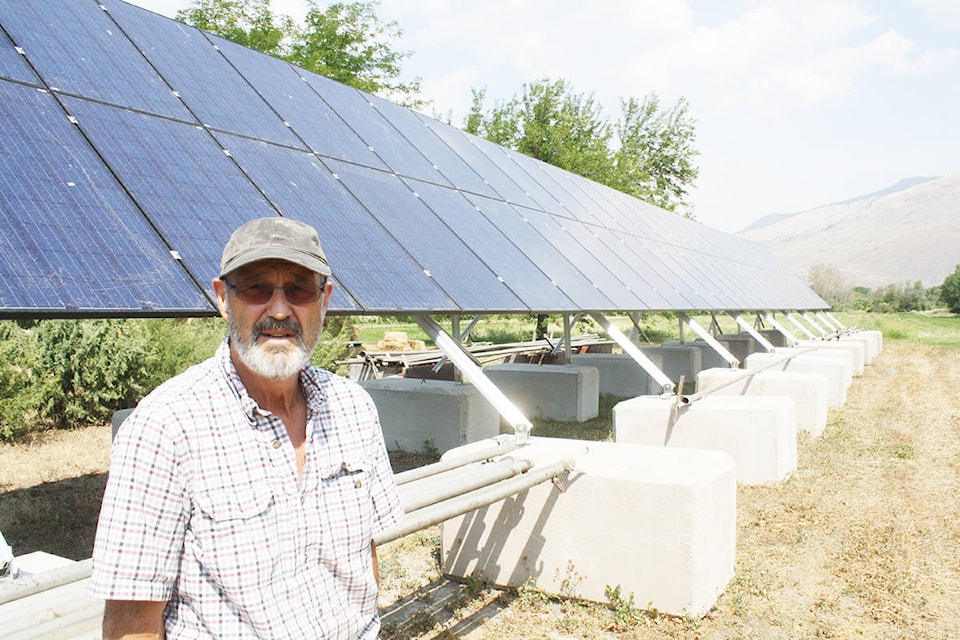Owners of a popular Cawston garlic farm hope that neighbours will follow suit and invest in solar power and the government will step in and help grow the renewable market.
Morris Holmes and Yvonne Kosugi owner of Farmersdotter Organics put up a 70-panel solar array on their farm earlier this spring.
“We thought it was the right thing to do,” Holmes said. “One of our mottos is vote with your wallet. As a consumer of resources we have a considerable footprint. We want to mitigate that footprint and give back.”
The large solar panel installation will create in the area of 21,000 to 24,000 kilowatt hours per year.
The hope is to offset the farm’s hydro consumption, which includes irrigation for growing about seven tonnes of Red Russian garlic each year, producing garlic scape salt, baking bread and the recent opening of two guest suites, staff housing and a main residence.
The cost of the solar array was about $55,000 to install.
Holmes said in a few years, depending on how much energy is produced from the panels and how much is used in the farm operation, they might choose to install another similar sized array.
“It is an investment for sure. But really when you think about it people easily pay $55,000 or in excess for a new pickup. That pickup depreciates in value over time. The solar panels shouldn’t. They should make you money or at least pay your hydro bill over time,” he said.
At current rates through net metering, Holmes estimates he will have the panels paid off in about 16 years.The installation has a 25-year guarantee.
Every time hydro rates rise the more money the panels make and the amount of time to pay it off goes down.
“Actually rates going up works in our favour now,” he said.
At this point the government is not providing incentives for installing solar.
Holmes has an agreement that Fortis will buy the hydro and take that amount of his monthly bill. If more hydro is produced than used a credit will apply. Fortis can terminate the agreement at anytime.
Although Holmes doesn’t think there should be a huge monetary incentive for those installing solar, he said he’d like to see the government step up in some way to help encourage renewable energy.
“The government can’t give lip service to the environment and say it’s a priority and then not provide support for this type of energy production. They’re giving subsidies to so many other energy industries just look at Site C and LNG. I think there’s room to be encouraging the growth of renewable energy,” he said.
In full agreement is manger of Argon Solar Dave Malmberg who installed the array at Farmersdotter.
Although he stopped short of saying what types of incentives would work best he said the renewable energy sector could benefit from some government support.
“It doesn’t have to be a large incentive. It could be tax credits or something else. Really what we’re looking for is an acknowledgment from leadership that renewables are a viable and valid energy option,” he said.
Argon is an Oliver based company that has been installing residential and commercial solar projects for about the last four years.
Malmberg said in the last year Argon has completed 10 solar projects in the Similkameen accounting for about half of the projects he’s been involved with.
The projects have ranged from eight-panel installs on roofs of houses to the 70-panel Farmersdotter project.
“It’s weird that some places just have a mental block on solar. But then there are other places like Cawston and Keremeos that are going ahead with projects. Maybe it’s because there are more organic fruit farmers and that’s driving other people to think along those lines,” he said.
Malmberg said a lot of the company’s clients are in the Baby Boomer age range or young couples who see solar panels as not only a way to help impact the challenges facing the environment but also as a good investment option.
“The fact is is that an installed system overtime is going to cost you about the same as it does for power and it’s like guaranteeing your paying a low rate for hydro. If they raise hydro rates you make more money. That will offset costs,” he said.
